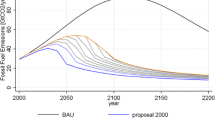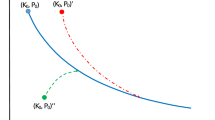Abstract
We apply four alternative decision criteria, two old ones and two new, to the question of the appropriate level of greenhouse gas emission reduction. In all cases, we consider a uniform carbon tax that is applied to all emissions from all sectors and all countries; and that increases over time with the discount rate. For a one per cent pure rate of the time preference and a rate of risk aversion of one, the tax that maximises expected net present welfare equals $120/tC in 2010. However, we also find evidence that the uncertainty about welfare may well have fat tails so that the sample mean exists only by virtue of the finite number of runs in our Monte Carlo analysis. This is consistent with Weitzman’s Dismal Theorem. We therefore consider minimax regret as a decision criterion. As regret is defined on the positive real line, we in fact consider large percentiles instead of the ill-defined maximum. Depending on the percentile used, the recommended tax lies between $100 and $170/tC. Regret is a measure of the slope of the welfare function, while we are in fact concerned about the level of welfare. We therefore minimise the tail risk, defined as the expected welfare below a percentile of the probability density function without climate policy. Depending on the percentile used, the recommended tax lies between $20 and $330/tC. We also minimise the fatness of the tails, as measured by the p-value of the test of the null hypothesis that recursive mean welfare is non-stationary in the number of Monte Carlo runs. We cannot reject the null hypothesis of non-stationarity at the 5 % confidence level, but come closest for an initial tax of $50/tC. All four alternative decision criteria rapidly improve as modest taxes are introduced, but gradually deteriorate if the tax is too high. That implies that the appropriate tax is an interior solution. In stark contrast to some of the interpretations of the Dismal Theorem, we find that fat tails by no means justify arbitrarily large carbon taxes.






Similar content being viewed by others
Notes
Note that Hof et al. (2010) do a cost-benefit analysis under worst-case assumptions, incorrectly referring to this as minimax regret.
Just like the mean, any percentile is based on the entire distribution.
The period of 1950–2000 is used for the calibration of the model, which is based on the IMAGE 100-year database (Batjes and Goldewijk 1994). The scenario for the period 2010–2100 is based on the EMF14 Standardised Scenario, which lies somewhere in between IS92a and IS92f (Leggett et al. 1992). The 2000–2010 period is interpolated from the immediate past (http://earthtrends.wri.org), and the period 2100–3000 extrapolated.
Recall that the law of large numbers is independent of the dimensionality or complexity of the data generating process.
The rate of the decline of the carbon tax was set by trial and error; the chosen rate ensures that greenhouse gas concentrations do not increase.
Note that we numerically derive the entire objective function instead of finding its optimum through successive approximations of the objective function; we do this for the four alternative decision criteria considered in this paper.
Recall that the definition of regret requires that the optimum tax be found for each state of the world, that is 10,000 times in our case. We saved the value of the objective function for each state of the world and each tax. This is possible as we defined policy such that it can be characterised by a single number (the initial tax) and as discretised that initial tax.
References
Anthoff, D., & Tol, R. S. J. (2010). On international equity weights and national decision making on climate change. Journal of Environmental Economics and Management, 60(1), 14–20.
Batjes, J. J., & Goldewijk, C. G. M. (1994). The IMAGE 2 hundred year (1890–1990). Database of the global environmen (HYDE) (410100082). Bilthoven: RIVM.
Boos, D. D. (1984). Using extreme value theory to estimate large percentiles. Technometrics, 26(1), 33–39.
Cline, W. R. (1992). Global warming—the benefits of emission abatement. Paris: OECD.
Fankhauser, S. (1994). Protection vs. retreat—the economic costs of sea level rise. Environment & Planning A, 27, 299–319.
Froyn, C. B. (2005). Decision criteria, scientific uncertainty, and the global warming controversy. Mitigation and Adaptation Strategies for Global Change, 10(2), 183–211.
Geweke, J. (2001). A note on some limitations of CRRA utility. Economics Letters, 71(3), 341–345.
Guo, J., Hepburn, C. J., Tol, R. S. J., & Anthoff, D. (2006). Discounting and the social cost of climate change: a closer look at uncertainty. Environmental Science & Policy, 9, 205–216.
Hammitt, J. K., Lempert, R. J., & Schlesinger, M. E. (1992). A sequential-decision strategy for abating climate change. Nature, 357, 315–318.
Hennlock, M. (2009). Robust control in global warming management: an analytical dynamic integrated assessment. Working papers in economics (Vol. 354). Gothenburg: Department of Economics, University of Gothenburg.
Hof, A. F., den Elzen, M. J. G., & van Vuuren, D. P. (2010). A Quantitative Minimax Regret Approach to Climate Change: Does Discounting Still Matter? Ecological Economics, 70(1), 43–51.
Hope, C. W. (2008). Optimal carbon emissions and the social cost of carbon over time under uncertainty. Integrated Assessment Journal, 8(1), 107–122.
Kattenberg, A., Giorgi, F., Grassl, H., Meehl, G. A., Mitchell, J. F. B., Stouffer, R. J., Tokioka, T., Weaver, A. J., & Wigley, T. M. L. (1996). Climate models—projections of future climate. In J. T. Houghton et al. (Eds.), Climate change 1995: the science of climate change—contribution of working group I to the second assessment report of the intergovernmental panel on climate change (1st ed., pp. 285–357). Cambridge: Cambridge University Press.
Leggett, J., Pepper, W. J., & Swart, R. J. (1992). Emissions scenarios for the IPCC: an update. In J. T. Houghton, B. A. Callander, & S. K. Varney (Eds.), Climate change 1992—the supplementary report to the IPCC scientific assessment (1st ed. Vol. 1, pp. 71–95). Cambridge: Cambridge University Press.
Link, P. M., & Tol, R. S. J. (2004). Possible economic impacts of a shutdown of the thermohaline circulation: an application of FUND. Portuguese Economic Journal, 3(2), 99–114.
Loulou, R., & Kanudia, A. (1999). Minimax regret strategies for greenhouse gas abatement: methodology and application. Operations Research Letters, 25(5), 219–230.
Maier-Reimer, E., & Hasselmann, K. (1987). Transport and storage of carbon dioxide in the ocean: an inorganic ocean circulation carbon cycle model. Climate Dynamics, 2, 63–90.
Mendelsohn, R. O., Morrison, W. N., Schlesinger, M. E., & Andronova, N. G. (2000). Country-specific market impacts of climate change. Climatic Change, 45(3–4), 553–569.
Narita, D., Anthoff, D., & Tol, R. S. J. (2008). Damage costs of climate change through intensification of tropical cyclone activities: an application of FUND (Working paper 259). Dublin: Economic and Social Research Institute.
Narita, D., Anthoff, D., & Tol, R. S. J. (2009a). Damage costs of climate change through intensification of tropical cyclone activities: an application of FUND. Climate Research, 39, 87–97.
Narita, D., Anthoff, D., & Tol, R. S. J. (2009b). Economic costs of extratropical storms under climate change: an application of FUND (Working paper 274). Dublin: Economic and Social Research Institute.
Narita, D., Anthoff, D., & Tol, R. S. J. (2010). Economic costs of extratropical storms under climate change: an application of FUND. Journal of Environmental Planning and Management, 53(3), 371–384.
Nordhaus, W. D. (2008). A question of balance—weighing the options on global warming policies. New Haven: Yale University Press.
Nordhaus, W. D. (2009) An analysis of the Dismal theorem. Mimeo. New Haven: Department of Economics, Yale University.
Ramaswamy, V., Boucher, O., Haigh, J., Hauglustaine, D., Haywood, J., Myhre, G., Nakajima, T., Shi, G. Y., & Solomon, S. (2001). Radiative forcing of climate change. In J. T. Houghton & Y. Ding (Eds.), Climate change 2001: the scientific basis—contribution of working group I to the third assessment report of the intergovernmental panel on climate change (pp. 349–416). Cambridge: Cambridge University Press.
Savage, L. J. (1951). The theory of statistical decision. Journal of the American Statistical Association, 46(253), 55–67.
Tol, R. S. J. (1995). The damage costs of climate change toward more comprehensive calculations. Environmental & Resource Economics, 5(4), 353–374.
Tol, R. S. J. (1997). On the optimal control of carbon dioxide emissions: an application of FUND. Environmental Modeling & Assessment, 2, 151–163.
Tol, R. S. J. (1999). The marginal costs of greenhouse gas emissions. Energy Journal, 20(1), 61–81.
Tol, R. S. J. (2001). Equitable cost-benefit analysis of climate change. Ecological Economics, 36(1), 71–85.
Tol, R. S. J. (2002a). Estimates of the damage costs of climate change—Part 1: Benchmark estimates. Environmental & Resource Economics, 21(1), 47–73.
Tol, R. S. J. (2002b). Estimates of the damage costs of climate change—Part II: Dynamic estimates. Environmental & Resource Economics, 21(2), 135–160.
Tol, R. S. J. (2002c). Welfare specifications and optimal control of climate change: an application of FUND. Energy Economics, 24, 367–376.
Tol, R. S. J. (2003). Is the uncertainty about climate change too large for expected cost-benefit analysis? Climatic Change, 56(3), 265–289.
Tol, R. S. J. (2005). Emission abatement versus development as strategies to reduce vulnerability to climate change: an application of FUND. Environment & Development Economics, 10(5), 615–629.
Tol, R. S. J. (2006). Multi-gas emission reduction for climate change policy: an application of FUND. Energy Journal, Multi-Greenhouse Gas Mitigation and Climate Policy, Special Issue, 235–250.
Tol, R. S. J. (2009). Climate feedbacks on the terrestrial biosphere and the economics of climate policy: an application of FUND (Working paper 288). Dublin: Economic and Social Research Institute.
Tol, R. S. J. (2010). International inequity aversion and the social cost of carbon. Climate Change Economics, 1(1), 21–32.
Tol, R. S. J., & Yohe, G. W. (2006). Of dangerous climate change and dangerous emission reduction. In H.-J. Schellnhuber et al. (Eds.), Avoiding dangerous climate change (pp. 291–298). Cambridge: Cambridge University Press.
Tol, R. S. J., & Yohe, G. W. (2007). Infinite uncertainty, forgotten feedbacks, and cost-benefit analysis of climate change. Climatic Change, 83(4), 429–442.
Tol, R. S. J., Downing, T. E., & Eyre, N. (1999). The marginal costs of radiatively-active gases (W99/32). Amsterdam: Institute for Environmental Studies, Vrije Universiteit.
Tol, R. S. J., Ebi, K. L., & Yohe, G. W. (2007). Infectious disease, development, and climate change: a scenario analysis. Environment & Development Economics, 12, 687–706.
van den Bergh, J. C. J. M. (2004). Optimal climate policy is a utopia: from quantitative to qualitative cost-benefit analysis. Ecological Economics, 48, 385–393.
Weissman, I. (1978). Estimation of parameters and larger quantiles based on the k largest observations. Journal of the American Statistical Association, 73(364), 812–815.
Weitzman, M. L. (2009). On modelling and interpreting the economics of catastrophic climate change. Review of Economics and Statistics, 91(1), 1–19.
Yohe, G. W. (2003). More trouble for cost-benefit analysis. Climatic Change, 56, 235–244.
Acknowledgements
An earlier version of this paper was presented at the ESOP Workshop on Climate and Distribution, Oslo, 22–23 June 2010 and at seminars at the Universities of East Anglia and Sussex; we are grateful to the participants for a useful discussion. An anonymous referee and Martin Weitzman also had useful comments on an earlier version of the paper. Financial support by the ClimateCost project is gratefully acknowledged.
Author information
Authors and Affiliations
Corresponding author
Rights and permissions
About this article
Cite this article
Anthoff, D., Tol, R.S.J. Climate policy under fat-tailed risk: an application of FUND . Ann Oper Res 220, 223–237 (2014). https://doi.org/10.1007/s10479-013-1343-2
Published:
Issue Date:
DOI: https://doi.org/10.1007/s10479-013-1343-2




